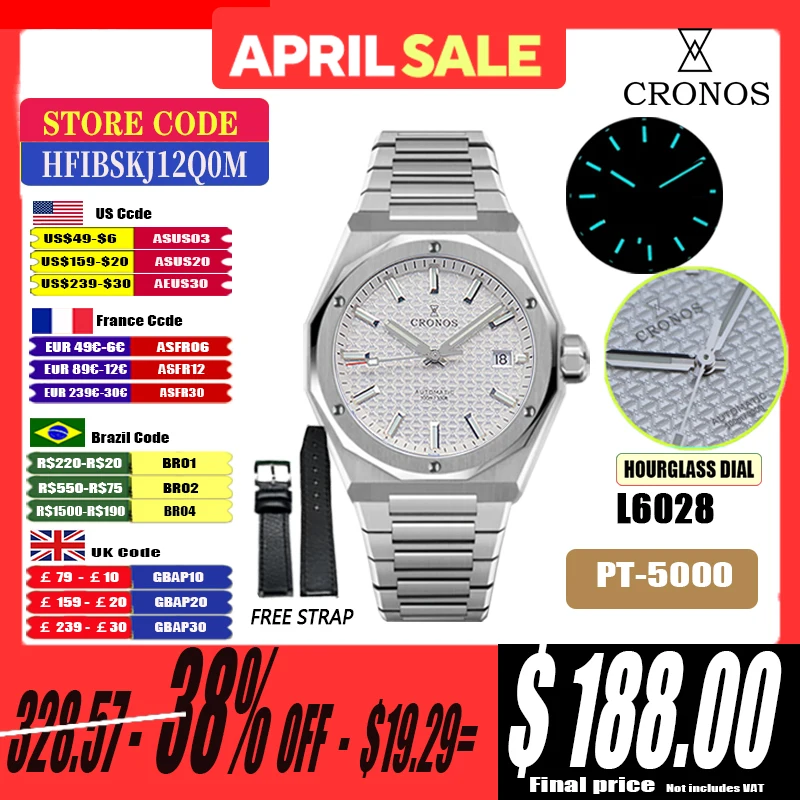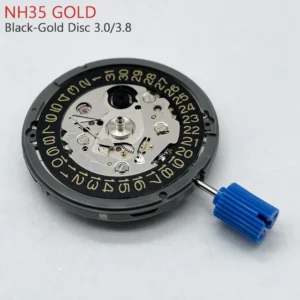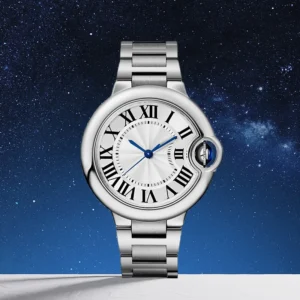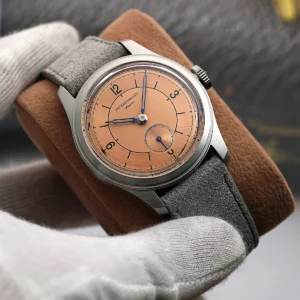Understanding the Soul of Elegance: What Makes a Dress Watch Dial Special
When it comes to a dress watch, the dial is more than just a face—it’s the soul of the timepiece. Unlike the bold functionality of sports watches or the complex displays of tool watches, a dress watch dial embodies understated sophistication. The magic of these dials lies in their ability to communicate elegance through restraint and precision.
The most distinctive features of dress watches include clean lines, excellent legibility, and timeless design elements that avoid trendy features. These watches aren’t meant to showcase technical prowess or survive extreme conditions—their purpose is to complement formal attire while displaying time with refined simplicity.
A dress watch dial typically follows certain core principles: balanced proportions, restrained decoration, and harmonious design elements. The dial works in concert with other classic dress watch characteristics like slim profiles, precious metal cases, and supple leather straps to create a complete expression of horological elegance.
The historical evolution of dress watches stems from pocket watches that transitioned to wristwear in the early 20th century. This heritage explains why many automatic dress watches maintain traditional aesthetics—they’re designed to honor the timeless art of watchmaking while remaining relevant in contemporary formal settings.
Essential Dial Layouts: Classic Designs That Define Dress Watches
The layout of a dress watch dial is like the architectural blueprint that defines its character. Several classic configurations have stood the test of time, each offering a different expression of formal elegance.
Two-Hand Minimalist Dials
The purest expression of a dress watch features only hour and minute hands. This minimalist approach celebrates the essence of timekeeping without distractions. The absence of a seconds hand creates a serene, uncluttered appearance that epitomizes formal restraint.
Three-Hand Traditional Dials
The most common dress watch configuration adds a central seconds hand to the hour and minute display. This layout provides the satisfaction of seeing smooth sweeping motion (in mechanical watches) while maintaining clean visual lines. The design elements in dress watches often include subtle details like tapered hands and precisely aligned markers.
Small Seconds Dials
A subsidiary seconds dial (typically positioned at 6 o’clock) offers a traditional aesthetic rooted in pocket watch design. This layout creates visual interest and asymmetry while maintaining formality. The small seconds configuration often appears in classic automatic dress watches from heritage brands.
Sector Dials
Featuring geometric divisions marked by concentric circles and radial lines, sector dials add architectural precision to dress watches. These divisions often separate hour and minute tracks, creating distinct zones on the dial. Despite their detailed appearance, sector dials maintain formality through geometric precision and balanced proportions.
Date Complications
While purists might argue that the perfect dress watch lacks any complications, modest date displays have become accepted in formal timepieces. The most elegant implementations use small windows or subdials that integrate harmoniously without disrupting the dial’s visual balance.
The Art of Simplicity: Minimalist Dress Watch Dials
The enduring appeal of minimalist dress watch dials lies in their adherence to the principle that “less is more.” These designs remove everything non-essential, leaving only what’s necessary for elegant time display.
Two-hand and three-hand minimalist dials achieve beauty through:
- Perfect proportions between hands, markers, and empty space
- Harmonious relationships between all visible elements
- Subtle variations in surface texture to add visual depth
- Precision alignment of minimal components
The challenge in creating exceptional minimalist automatic watches lies in achieving perfect balance without hiding behind decorative elements. When a dial has few components, each must be perfectly executed. The spacing between hour markers, the thickness of hands, and the proportions of every element become critical.
What makes minimalist designs so appropriate for formal occasions is their visual quietness. They don’t demand attention—instead, they complement formal attire by providing subtle refinement. The comparison between classic and minimalist styles reveals that both approaches can achieve formality through different means: one through traditional codes and the other through modern restraint.
Traditional Refinement: Small Seconds and Sector Dials
Small seconds and sector dials represent traditional approaches to dress watch design that add visual interest while maintaining formality.
Small seconds dials trace their heritage directly to pocket watches, where this configuration was standard. The placement of a subsidiary seconds dial (typically at 6 o’clock, though sometimes at 9 o’clock in vintage designs) creates visual counterpoint to the centered hour and minute hands. This asymmetry adds character without sacrificing elegance.
Sector dials, with their geometric divisions and architectural precision, represent another traditional approach that remains relevant today. These dials divide time into clear sectors using concentric circles and radial lines. The result is both visually engaging and highly legible, with distinct zones for hours, minutes, and sometimes seconds.
Both these traditional layouts appear frequently in manual-wind dress watches, connecting modern timepieces to horological heritage. The meticulous execution of these designs—with precise alignment, consistent finishing, and harmonious proportions—demonstrates how traditional formats can remain fresh and relevant.
Noble Metals: Gold and Platinum Dress Watch Dials
Nothing communicates luxury in a dress watch quite like a precious metal dial. These materials bring inherent value and distinctive visual characteristics that elevate formal timepieces.
Yellow gold dials exude traditional warmth and richness. With their unmistakable hue and substantial presence, they represent classical luxury. Yellow gold’s distinctive color works particularly well with black or brown leather straps, creating a timelessly elegant combination for formal occasions.
Rose (or pink) gold offers a warmer, softer alternative that has gained significant popularity in contemporary dress watches. Its reddish hue comes from copper alloy content and provides a subtle distinction from traditional yellow gold. Rose gold dials create a sophisticated yet slightly warmer aesthetic.
White gold presents understated luxury that’s often mistaken for steel at first glance. Its subtle brilliance reveals itself upon closer inspection, making it perfect for those who prefer discrete elegance. The rhodium plating typically applied to white gold dials enhances durability while creating a distinctive silvery appearance.
Platinum represents the pinnacle of precious metal dials, with its distinctive density and subtle grayish-white color. Exceptionally rare in watchmaking, platinum dials age beautifully and maintain their appearance indefinitely. The exclusivity of platinum makes it especially appropriate for the finest dress watches.
For those seeking accessible options with similar visual appeal, many gold-tone automatic watches offer comparable aesthetics at more approachable price points.
Silver and Steel: Classic Alternatives for Dress Watch Dials
While precious metals represent the traditional choice for luxury dress watches, silver and steel provide excellent alternatives that combine durability with classic elegance.
Silver dials offer traditional charm with a unique aging characteristic. Over time, silver develops a subtle patina that many enthusiasts appreciate as a sign of character. Historically significant in watchmaking, silver provides excellent contrast for applied markers and printed elements.
Stainless steel has become the modern standard for versatile dress watch dials. Its durability, resistance to corrosion, and ability to take various finishes make it practical for daily-wear dress watches. Steel dials can be brushed, polished, or textured to create different aesthetic effects while maintaining formal appropriateness.
Brass serves as an important base material in watchmaking, often plated with other finishes. When properly treated and finished, brass-based dials offer an excellent foundation for various treatments including:
- Rhodium plating for increased durability and brilliant appearance
- Silver plating for traditional elegance
- PVD coatings in various colors for contemporary interpretations
These materials offer exceptional value, balancing initial affordability with long-term durability—an important consideration for watches intended to become heirlooms.
Artisanal Excellence: Enamel Dial Craftsmanship
Enamel dials represent one of watchmaking’s highest artisanal traditions, combining ancient techniques with unmatched visual depth and permanence.
Grand Feu enamel—meaning “great fire” in French—involves applying powdered glass to a metal base and firing it at extremely high temperatures (typically 800-900°C). This process is repeated multiple times to build up layers, creating a perfectly smooth surface with extraordinary depth. The resulting dials offer a distinctive creamy appearance that never fades and a subtle translucence that cannot be replicated by other materials.
The creation process demands exceptional skill:
1. Preparing a copper or gold base disc
2. Applying precisely formulated enamel powder
3. Firing at extremely high temperatures
4. Repeating with additional layers for depth
5. Final polishing to achieve perfect smoothness
Specialized enamel techniques add further dimension to dress watch dials. Cloisonné uses thin gold wire to create cells that are filled with different colored enamels. Champlevé carves recesses into the base metal before filling with enamel. Flinqué combines guilloche engraving with translucent enamel layers, creating remarkable depth and pattern.
The incredible durability of enamel makes these dials particularly special—they maintain their appearance indefinitely, with colors that never fade. This permanence makes enamel dials particularly valued in heirloom-quality dress watches.
Nature’s Canvas: Mother-of-Pearl, Stone, and Exotic Materials
Nature provides some of the most captivating materials for dress watch dials, each bringing unique visual properties that cannot be replicated artificially.
Mother-of-pearl stands out for its natural iridescence that shifts colors depending on viewing angle. Harvested from the inner layer of mollusk shells, each piece is unique with subtle variations in pattern and color play. The delicate material requires skilled handling during dial production, but the results offer unmatched organic beauty that works particularly well in formal timepieces.
Stone dials bring earth’s natural artistry to dress watches. Materials like onyx (deep black with subtle banding), lapis lazuli (rich blue with gold pyrite inclusions), and malachite (green with distinctive banding) create statement pieces that remain formal through their natural elegance. The challenge of working with brittle stone materials makes these dials particularly impressive technical achievements.
Meteorite dials, created from extraterrestrial iron-nickel alloys, display distinctive crystalline patterns called Widmanstätten structures. These cosmic patterns form over millions of years and appear when the material is cut, polished and acid-etched. Each meteorite dial is absolutely unique, containing patterns formed in space long before human civilization.
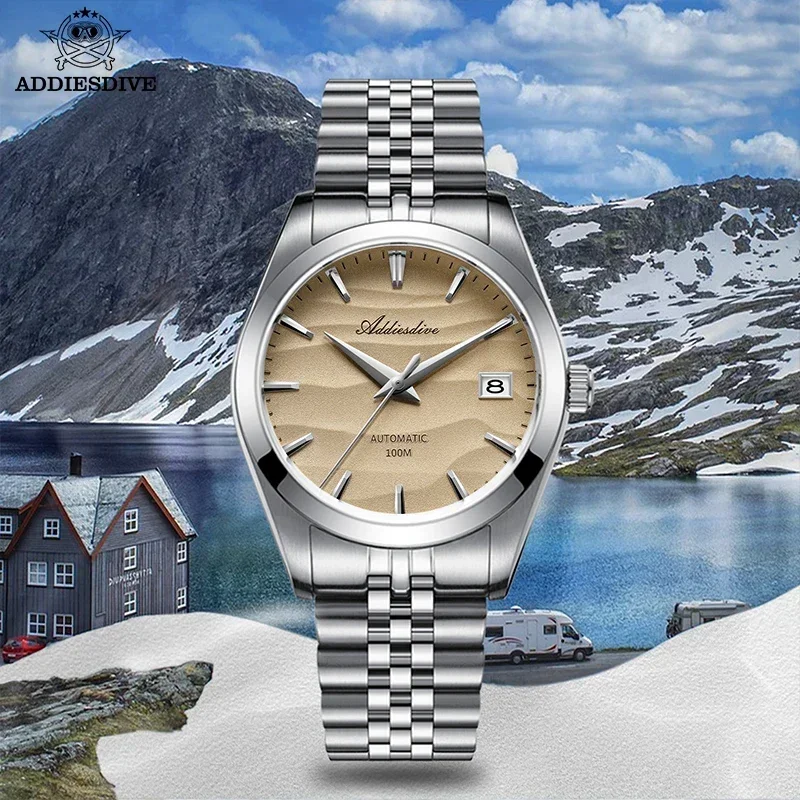
Surface Artistry: Essential Dial Finishes and Textures
The finish applied to a dress watch dial dramatically influences its character and how it interacts with light. Each technique creates different visual effects while maintaining formal elegance.
Sunburst (soleil) finishes create radial brushed patterns that emanate from the dial center. This technique produces dynamic light play, with the dial changing appearance as it moves. The subtle shimmer adds visual interest without compromising formality, making sunburst finishes particularly popular in contemporary dress watches.
Matte and frosted surfaces offer understated sophistication through their non-reflective appearance. These finishes create a soft, uniform look that emphasizes dial elements like applied markers and hands. Particularly appropriate for the most formal occasions, matte dials never distract with unwanted reflections.
Grained finishes apply minute texture to create subtle visual interest and excellent legibility. The fine-grained surface diffuses light without creating distinct reflections, striking an excellent balance between visual depth and formal restraint.
Polished dials maximize material brilliance by creating mirror-like surfaces. This technique works particularly well with precious metals, showcasing their inherent beauty. While more reflective than other finishes, properly executed polished dials maintain formality through their precise execution.
Different finishes significantly impact how a watch transitions between formal and casual settings, making finish selection an important consideration when choosing the quintessential dress watch features for your specific needs.
Guilloché Excellence: The Art of Decorative Engraving
Guilloché represents the pinnacle of decorative dial techniques, using precise geometric patterns to create extraordinary visual texture while maintaining formal elegance.
Traditional hand-guilloché involves using a rose engine—a specialized lathe-like machine—to engrave intricate patterns into metal. The artisan guides the cutting tool by hand, creating patterns of remarkable precision and consistency. This traditional technique requires years of training to master and produces results with subtle variations that reveal their hand-crafted nature.
Common guilloché patterns include:
- Clous de Paris (hobnail): intersecting diagonal lines creating a pyramid-like texture
- Barleycorn: oval patterns arranged in rows resembling grains
- Waves: parallel or radiating undulating lines
- Basketweave: intersecting bands creating a woven appearance
Machine-stamped patterns can simulate guilloché effects at lower production costs, but lack the depth and character of true hand-engraved work. Discerning collectors prize the subtle inconsistencies and deeper cuts of authentic hand-guilloché.
The beauty of guilloché patterns lies in their ability to add visual complexity while maintaining formality. By using geometric precision rather than pictorial decoration, these patterns create interest without compromising the dress watch’s formal character.
The Final Touch: Hour Markers and Hands
Hour markers and hands complete a dress watch dial, defining its character and legibility while adding crucial design elements.
Applied markers—physically attached to the dial rather than printed—create dimension and sophistication. Their raised profile catches light differently than the dial surface, enhancing legibility and visual interest. Common styles include:
- Simple batons: rectangular markers representing the essence of modern minimalism
- Roman numerals: traditional markers with classical elegance
- Arabic numerals: offering excellent legibility with traditional or contemporary styling
- Diamond markers: providing subtle brilliance for more luxurious pieces
Hand styles significantly impact a dress watch’s character. Classic dress watch hands include:
- Dauphine: broad, faceted hands that taper to a point
- Leaf: elegant, curved hands with organic form
- Baton: simple, straight hands echoing rectangular markers
- Breguet: distinguished by hollow eccentric circles near their tips
- Sword: sharp, pointed hands with strong linear presence
The relationship between hands and markers creates visual harmony when properly executed. The most elegant dress watches feature hands whose width proportionally matches marker thickness, with stylistic elements that echo each other. This attention to detail creates cohesive designs where every element belongs to a unified whole.
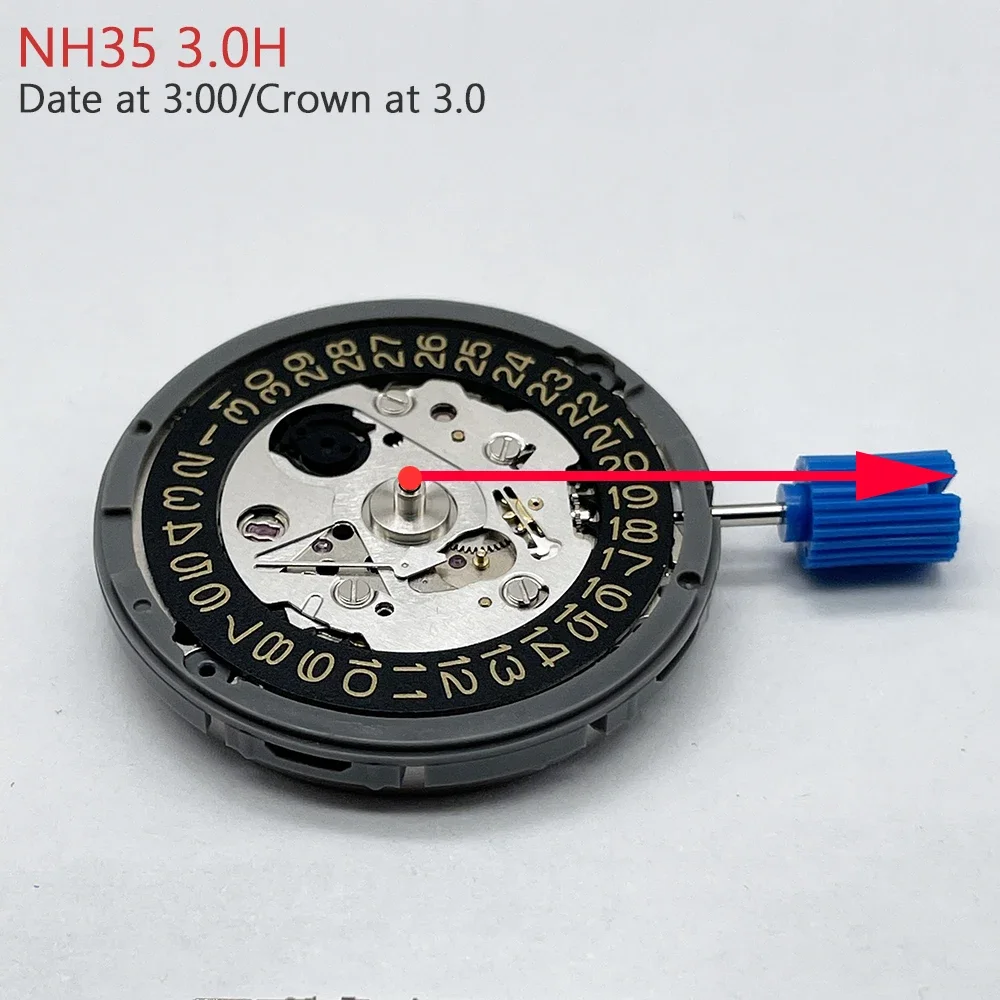
Classic Automatic Dress Watches, Day Date Automatic Watches, Perpetual Calendar Automatic Watches
Price range: $540.60 through $574.60 Select options This product has multiple variants. The options may be chosen on the product pageClassic Automatic Dress Watches, GMT Automatic Watches, GMT Pilot Watches
Price range: $1,240.86 through $1,463.33 Select options This product has multiple variants. The options may be chosen on the product pageAutomatic Skeleton Watches, Open Heart Automatic Watches
$98.36 Select options This product has multiple variants. The options may be chosen on the product pageDay Date Automatic Watches, Gold Tone Automatic Watches
$138.24 Select options This product has multiple variants. The options may be chosen on the product pageClassic Automatic Dress Watches, Thin Automatic Dress Watches
$437.64 Select options This product has multiple variants. The options may be chosen on the product pageClassic Manual Wind Watches, Manual Wind Dress Watches
Price range: $425.50 through $462.50 Select options This product has multiple variants. The options may be chosen on the product page
Recognizing Quality: Expert Assessment of Dress Watch Dials
Identifying quality in dress watch dials requires attention to specific details that reveal craftsmanship and execution standards.
Key quality indicators include:
- Printing precision: text and minute tracks should have sharp edges without bleeding or inconsistency
- Applied marker alignment: markers should align perfectly with minute tracks and be centered on their positions
- Hand finishing: look for polished edges, consistent surfaces, and precise fitting at the center
- Material consistency: uniform color and texture across the entire dial
- Depth and dimension: quality dials create visual layers through multiple elements
Manufacturing shortcuts often appear as inconsistent application of finishes, poorly aligned markers, or uneven printing. At higher price points, even minute flaws become significant, while budget-friendly watches may show more acceptable tolerances.
The relationship between price and execution is generally consistent—higher prices should deliver proportionally better finishing. However, some brands deliver exceptional quality relative to their price point by focusing on dial excellence while saving costs in other areas.
Is a Skeleton or Open-Heart Design Still a Dress Watch?
Traditional dress watch guidelines would classify skeleton or open-heart designs as inappropriate for formal wear—the fundamental principle being that simpler is dressier. However, contemporary interpretations have expanded these boundaries.
Modern skeleton watches can maintain formal elegance when their execution emphasizes refinement over mechanical demonstration. Key factors that help skeleton designs work in formal settings include:
- Symmetrical movement architecture
- Refined finishing on all visible components
- Restrained use of color
- Maintaining a slim profile despite the exposed mechanics
The open-heart design concept represents a compromise between traditional solid dials and full skeletonization. By revealing just a portion of the movement—typically the balance wheel—open-heart watches provide mechanical interest while maintaining much of the dial’s formal structure.
For those who appreciate mechanical artistry but require formal versatility, skeleton or open-heart watches with slim profiles, precious metal cases, and restrained design language can successfully bridge traditional and contemporary dress watch definitions.
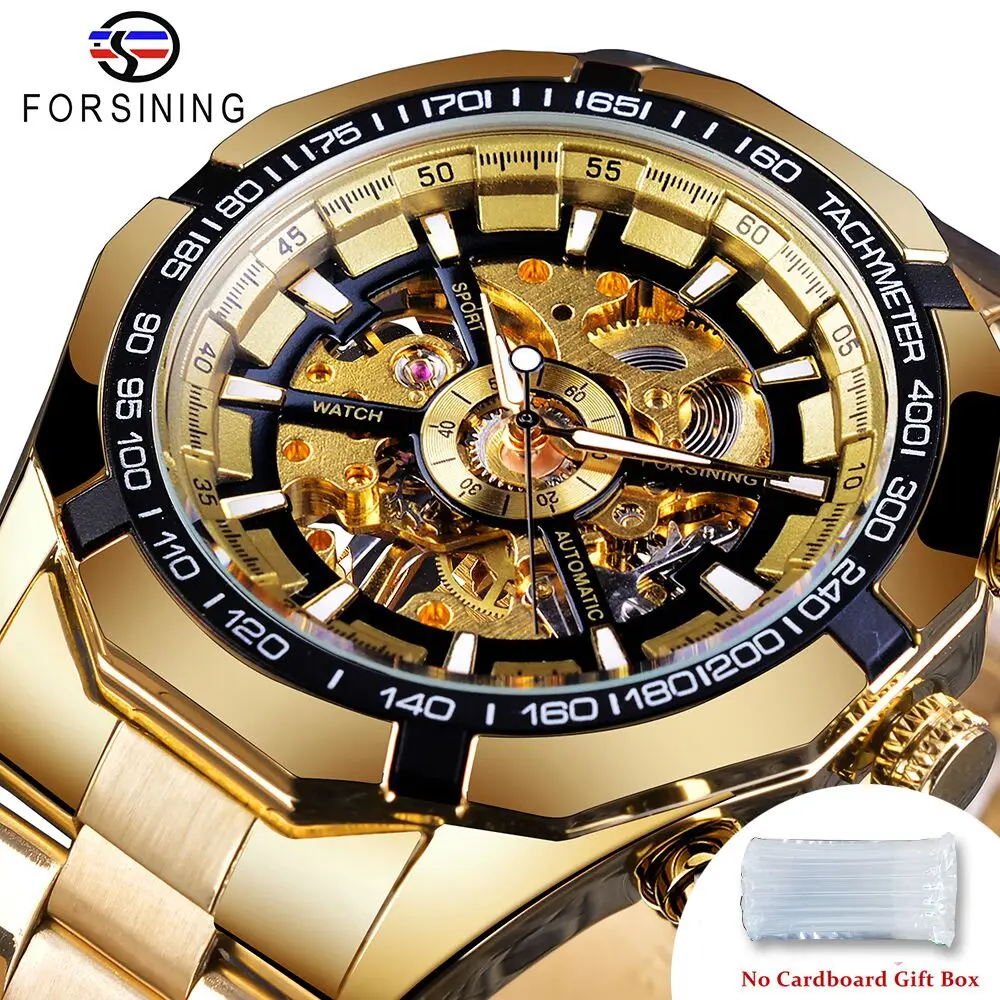
How Do Watch Dials Reflect Brand Heritage and Design Language?
Watch dials serve as the primary canvas for expressing brand identity and heritage. Distinctive dial treatments often become signature elements instantly recognizable to enthusiasts.
Many heritage watchmakers maintain consistent dial design languages across decades or even centuries, creating continuity through specific typography, logo placement, hand shapes, or decorative techniques. These characteristics of classic dress watches often become so associated with specific brands that they’re recognizable even without logos.
Newer brands establish their identity through deliberate dial design choices—whether by innovating with modern materials, reviving historical techniques, or creating distinctive layouts. The most successful establish coherent design languages that communicate their values and positioning.
Brand signatures might include particular guilloché patterns, distinctive hand shapes, unique marker styles, or proprietary dial materials. The consistency of these elements across collections helps build brand recognition and legacy.
How to Select the Perfect Dress Watch Dial for Your Style
Choosing the ideal dress watch dial requires balancing personal style with practical considerations and understanding how different elements affect versatility.
Start by considering your typical formal environments—conservative professional settings might call for more traditional dials, while creative fields allow for greater expression. The watch that works perfectly in a banking environment might differ from one appropriate for creative professions.
Skin tone plays a subtle but important role in dial selection. Warmer skin tones often pair beautifully with gold, cream, or champagne dials, while cooler complexions may harmonize better with silver, white, or blue dials. This relationship isn’t rigid, but considering how a dial color complements your natural coloring can enhance the overall aesthetic.
When seeking versatility, consider the balance between timeless design and current trends. Classically proportioned three-hand dials with simple markers tend to maintain relevance across decades, while more distinctive designs might make stronger statements but potentially feel dated sooner.
For those new to dress watches, identifying the perfect dress watch often begins with understanding classic proportions and designs before exploring more distinctive variations. Many collectors find that thin automatic dress watches offer excellent versatility, slipping easily under shirt cuffs while maintaining elegant proportions.
The perfect dress watch dial ultimately combines personal preference with appropriate formality for your needs—creating a timepiece that enhances your appearance while expressing your individual style.

